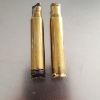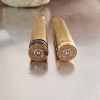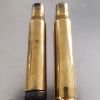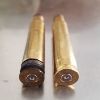I just started reloading and I am obviously doing something wrong and need help. I am shooting a Remington 700 30-06 using once fired (from factory loads) Remington brass. All of the brass was fired from this rifle. I am using CCI #200 primers and Nosler 165 gn ballistic tip. I am neck sizing using the Lee ultimate die set. I trimmed all the casings (although none of them actually needed it). The brass was tumbled and deburred. I didn't use a polish in my walnut shell media so there were still burn marks on the brass and someone suggested that I try steel wool to take it off. I put the brass on a drill and further polished with the steel wool. I seated all the rounds to an OAL of 3.320.
For my first 5 shots I used 49 gn of IMR 4064 and crimped. These shots were successful. I then increased the load to 49.5 gn and crimped. The first shot made a wrinkle on the casing that I didn't notice until later. The second shot split the casing (see picture) which sent powder and casing shrapnel back to me and fried my extractor. The split only goes around 50% of the casing. The shot was much louder and the gun almost jumped out of my hand. The point of impact was 5" lower than the previous shot. I replaced the extractor and took my rifle and casings to a gunsmith (and a few other people) and they suggested the powder was too hot, switch to IMR 4350, and don't crimp. The gunsmith also checked my chamber with go/no-go gauges (it passed).


I took their advice and then loaded 54 gn of IMR 4350 and no crimp. The first shot was successful and didn't wrinkle the casing. The second shot cracked exactly the same as the other although this time it did not fry the extractor and I took shrapnel in knuckle of my thumb and cheek.


Any thoughts? I'm obviously not going to hand shoot this rifle again until I feel confident that this issue has been determined. Thank you in advance!
For my first 5 shots I used 49 gn of IMR 4064 and crimped. These shots were successful. I then increased the load to 49.5 gn and crimped. The first shot made a wrinkle on the casing that I didn't notice until later. The second shot split the casing (see picture) which sent powder and casing shrapnel back to me and fried my extractor. The split only goes around 50% of the casing. The shot was much louder and the gun almost jumped out of my hand. The point of impact was 5" lower than the previous shot. I replaced the extractor and took my rifle and casings to a gunsmith (and a few other people) and they suggested the powder was too hot, switch to IMR 4350, and don't crimp. The gunsmith also checked my chamber with go/no-go gauges (it passed).


I took their advice and then loaded 54 gn of IMR 4350 and no crimp. The first shot was successful and didn't wrinkle the casing. The second shot cracked exactly the same as the other although this time it did not fry the extractor and I took shrapnel in knuckle of my thumb and cheek.


Any thoughts? I'm obviously not going to hand shoot this rifle again until I feel confident that this issue has been determined. Thank you in advance!













